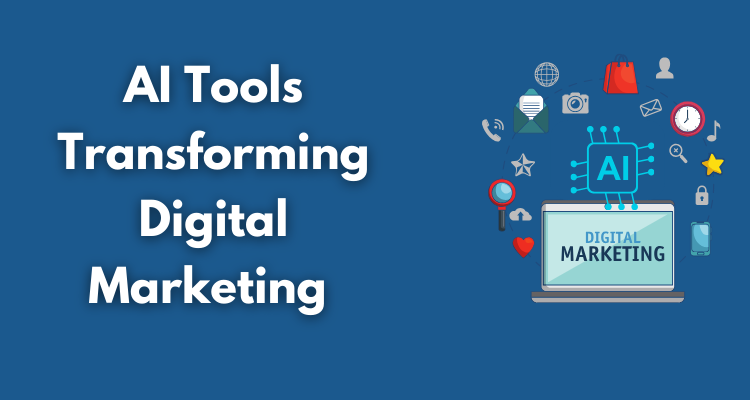In 2025, artificial intelligence (AI) is no longer a futuristic concept — it’s a standard part of digital marketing. From chatbots that handle customer queries to algorithms that write ad copy, AI is transforming how businesses attract, engage, and convert customers.
If you know how to use AI effectively, you can save time, reduce costs, and improve marketing performance. This guide will explain how AI is used in digital marketing, which tools to try, and tips for getting the best results.
Why AI Matters in Digital Marketing
- Saves Time – Automates repetitive tasks like sending emails or scheduling social posts.
- Improves Accuracy – AI can analyze huge datasets to make better predictions.
- Personalizes Marketing – Creates tailored experiences for individual customers.
- Boosts ROI – Optimizes ad targeting and content for higher conversions.
- Scales Effortlessly – Handles large marketing campaigns without increasing workload.
How AI Is Used in Digital Marketing in 2025
1. Content Creation and Optimization
AI can write blog posts, ad copy, product descriptions, and even video scripts.
- Example Tools: Jasper, Copy.ai, Writesonic, ChatGPT
- Best Use: Drafting content quickly, then refining it with human editing for personality and accuracy.
2. Search Engine Optimization (SEO)
AI helps find the best keywords, analyze competitors, and suggest content improvements.
- Example Tools: Surfer SEO, Clearscope, MarketMuse
- Best Use: Optimizing existing content and creating SEO-friendly articles faster.
3. Social Media Management
AI tools schedule posts, analyze engagement, and suggest trending topics.
- Example Tools: Buffer AI, Lately.ai, SocialBee
- Best Use: Automating repetitive posting while keeping the human touch for engagement.
4. Paid Advertising Optimization
AI automatically adjusts ad targeting, bidding, and creatives for better ROI.
- Example Tools: Google Ads Smart Bidding, AdCreative.ai, Revealbot
- Best Use: Scaling campaigns without overspending.
5. Email Marketing Automation
AI decides the best time to send emails, personalizes subject lines, and segments audiences.
- Example Tools: ActiveCampaign, Mailchimp AI, Klaviyo
- Best Use: Sending highly personalized campaigns at scale.
6. Customer Support and Chatbots
AI-powered chatbots provide instant answers 24/7, reducing the need for large support teams.
- Example Tools: Intercom, Drift, ManyChat
- Best Use: Handling common customer queries while human agents tackle complex issues.
7. Predictive Analytics
AI predicts customer behavior, such as who is most likely to buy or unsubscribe.
- Example Tools: Pecan AI, HubSpot Predictive Lead Scoring
- Best Use: Focusing marketing efforts on high-value leads.
Benefits of Using AI in Marketing
- Faster decision-making based on real-time data.
- Better customer experiences through personalization.
- Reduced human error in campaign management.
- Ability to handle large-scale marketing without extra manpower.
Challenges of AI in Marketing
- Lack of human creativity – AI still struggles with emotional storytelling.
- Data privacy concerns – Must follow GDPR and other regulations.
- Over-reliance on automation – Can make marketing feel robotic if not balanced.
Best Practices for Using AI in 2025
- Combine AI with Human Creativity – Use AI for speed, humans for brand voice.
- Start Small – Test AI on a single process before rolling out widely.
- Use Quality Data – AI is only as good as the data it learns from.
- Monitor and Adjust – Don’t set AI campaigns on autopilot forever.
- Stay Ethical – Be transparent when using AI-generated content.
AI Marketing Tools to Try in 2025
| Purpose | Tool | Key Feature |
|---|---|---|
| Content Creation | Jasper | AI blog writing |
| SEO | Surfer SEO | On-page optimization |
| Ads | AdCreative.ai | AI ad designs |
| Klaviyo AI | Predictive segmentation | |
| Social Media | Lately.ai | Repurposes content automatically |
| Chatbots | ManyChat | Automated conversations |
Trends in AI Marketing for 2025
- Hyper-Personalized Experiences – AI will deliver unique content to each user.
- AI Video Creation – Tools will make high-quality marketing videos in minutes.
- Voice and Conversational AI – More voice-based search and customer interactions.
- AI-Powered Influencer Selection – Finding influencers with genuine engagement.
- Ethical AI Guidelines – Stricter rules on transparency in AI use.
Common Mistakes to Avoid
- Using AI without reviewing the output.
- Automating everything and losing the human touch.
- Ignoring privacy laws when collecting data.
- Relying solely on AI without creative strategy.
Conclusion
AI is a game-changer for digital marketing in 2025, but it’s most effective when used as a partner, not a replacement, for human creativity. By understanding the tools available and following best practices, you can save time, improve results, and deliver better experiences for your audience.
The future of marketing is human + AI working together — and those who master this balance will lead the way.

